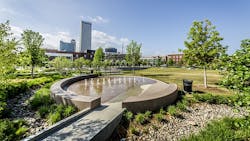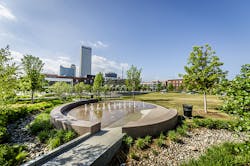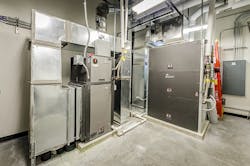Geothermal Heating and Cooling Plays Key Role in Urban-Reuse Project
Once the site of manufacturing and warehouse facilities, Guthrie Green is a public green space and arts complex in downtown Tulsa, Okla. Situated on a square block in the heart of the city’s Brady Arts District, the park features an outdoor stage, The Dock pavilion, walking and bicycling paths, seating areas, and lawns. Additionally, the renovated Tulsa Paper Co. building and new Hardesty Arts Center building house office, meeting, event, performance, gallery, classroom, and retail space.
In addition to an example of urban reuse, Guthrie Green serves as a testament to sustainability, with numerous green and renewable elements incorporated into its design.
“All lighting on the site is LED, reducing the overall site demand for electricity, and water runoff on the site is diverted to bioswales, which help irrigate the landscape and clean the water before it enters the storm sewer,” Justin Roush, project manager for Flynt & Kallenberger Consulting Engineers, said. “Also, solar panels on the roof of The Dock contribute to the overall energy demands of the park’s amenities.”
Roush said the “greenest” component of Guthrie Green’s sustainable-building plan lies below the grass, benches, and stage. This is where a field of 120 500-ft geothermal boreholes was drilled prior to the above-ground construction. The field ties into a hybrid system of geothermal heat pumps and a ground-mounted cooling tower that serve as the main mechanical systems for the Tulsa Paper Co. and Hardesty Arts Center buildings.
The geothermal-borehole field, which is organized into 15 operating circuits, provides 600 tons of heating and cooling to both buildings, with the capability of reducing heating and cooling costs by approximately 60 percent.
“The 600 tons from the geothermal field is supplemented with a 200-ton closed-circuit fluid cooler, which was incorporated into the overall system design when taking the peak demands of all four end users into account,” Roush said. “Each of the tenants has a water-to-water heat exchanger that enables them to use the loop water on one side while keeping their individual systems separated. That way, if they wanted to create chilled water or put equipment on the roof and use glycol, these elements can’t ultimately end up in the main loop water.”
The mechanical system inside the 40,000-sq-ft Tulsa Paper Co. building features 15 geothermal-heat-pump systems from ClimateMaster: nine 8- to 14-ton Tranquility Rooftop (TRE) Series units, four 2- to 6-ton Tranquility 30 Two-Stage (TT) Series units, one 7½-ton Tranquility Large (TL) Series unit, and one 8-ton Tranquility 16 Compact (TC) Series unit. In the 42,500-sq-ft Hardesty Visual Arts Center, 59 ClimateMaster geothermal heat pumps—19 ¾-, 1-, and 1½-ton Tranquility 20 Single-Stage (TS) Series units, 31 2- to 6-ton Tranquility 30 TT Series units, six 2-ton Tranquility Console (TRC) Series units, and three 7- and 8-ton Tranquility Large Vertical (TL) Series units—are installed.
During the earliest stages of construction, two fuel tanks from a former gas station were discovered, with 12 more found during the initial geothermal-borehole-drilling process. All of the tanks were removed, and the land was remediated.
Stanton Doyle, senior program officer for owner George Kaiser Family Foundation, said the project is meant to foster ground-source-heat-pump-system installation in Oklahoma and to support businesses in the state that provide expertise in the design, installation, and manufacture of associated equipment.
“Geothermal is a cost-effective way to heat and cool a space, and it makes sense, particularly in this blighted urban district, as it can substantially reduce costs for local residents and business owners,” Doyle said.


